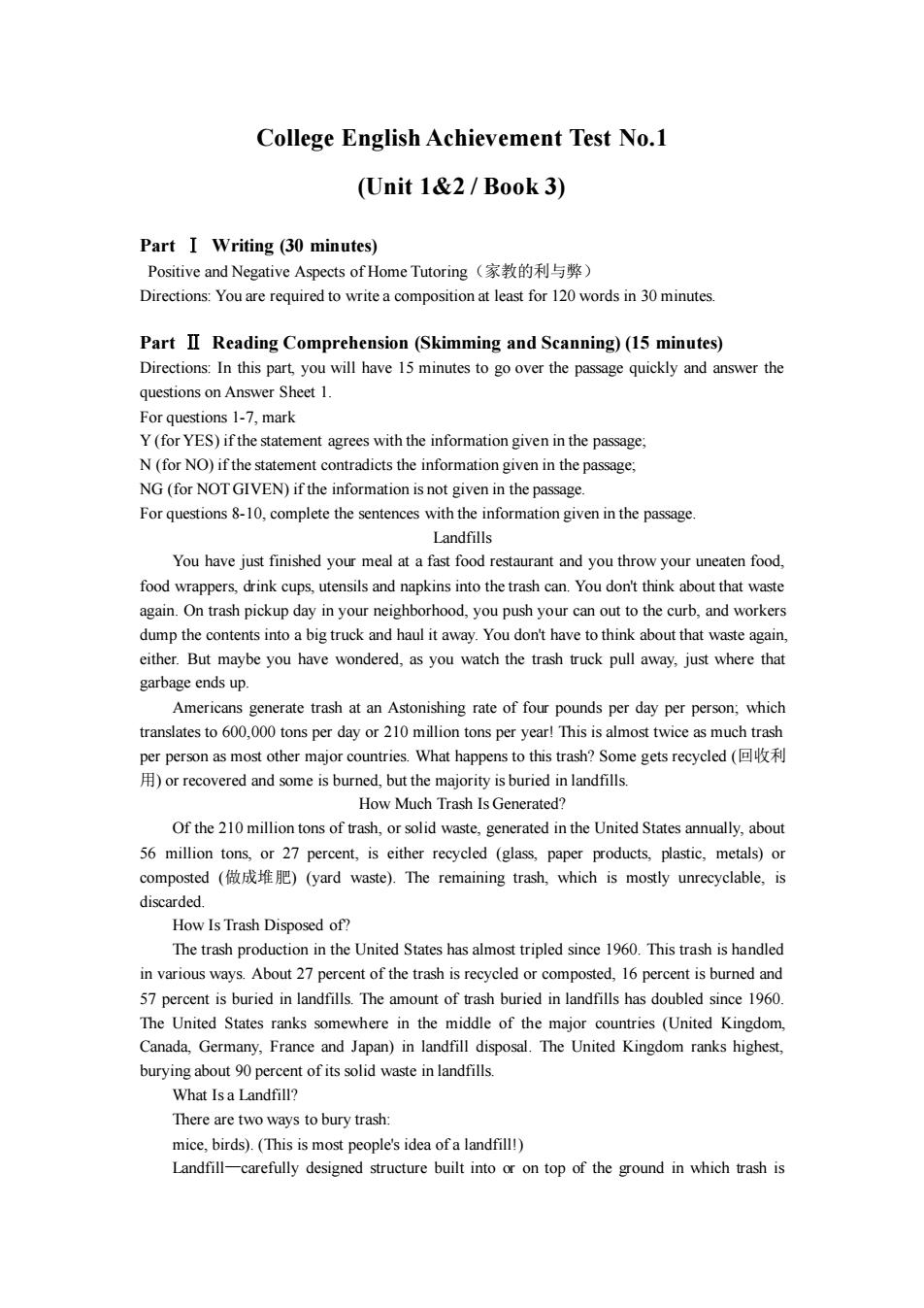
College English Achievement Test No.1 (Unit 1&2/Book 3) Part I Writing(30 minutes) Positive and Negative Aspects of Home Tutoring(家教的利与弊) Directions You are required to 120 words in30 minutes Part II Reading Comprehension(Skimming and Scanning)(15 minutes) Directions:In this part you will have 15 minutes to go over the passage quickly and answer the Viot vpag N(for NO)if the statement contradicts the information given in the passage; NG(for NOTGIVEN)if the information is not given in the passage. For questions8-10.complete the sentences with the information given in the passage You have yourmeal od estaurant and you throw your fod. food wrappersrink cups.utensils and napkins into the trash can.You don't think about that waste again.On trash pickup day in your neighborhood,you push your can out to the curb,and workers dump the contents into a big truck and haul it away.You don't have to think about that waste again, either.But maybe you have wondered,as you watch the trash truck pull away.just where that garbage ends Americans generate trash at an Astonishing rate of four pounds per day per person;which translates to 600.000 tons per day or 210 million tons per year!This is almost twice as much trash per person as most other major countries.What happens to this trash?Some gets recycled )or recovered and some is burned.but the maiority is buried in landfills. How much trash is ger ted? Of the 210 million tons of trash,or sod waste.generated in the United States annually,abou 56 million tons,or 27 percent,is either recycled (glass,paper products,plastic,metals)or composted(做成堆肥)(yard waste).The remaining trash,which is mostly unrecyclable,is discarded How Is Trash Disposed of? The trash production in the United States hasamost tripled.This trash ishandled in various ways.About 27percent of the trash is recycled or composted,16 percent is burned and 57 percent is buried in landfills.The amount of trash buried in landfills has doubled since 1960 The United States ranks somewhere in the middle of the major countries(United Kingdom, Canada.Germany,France and Japan)in landfill disposal.The United Kingdom ranks highest. burying about 9 percent of its solid waste in landfills. What Isa Landfill? There are two ways to bury trash. mice,birds).(This is most people's idea ofa landfill!) Landfill- carefully designed structure built into or on top of the ground in which trash is
College English Achievement Test No.1 (Unit 1&2 / Book 3) Part Ⅰ Writing (30 minutes) Positive and Negative Aspects of Home Tutoring(家教的利与弊) Directions: You are required to write a composition at least for 120 words in 30 minutes. Part Ⅱ Reading Comprehension (Skimming and Scanning) (15 minutes) Directions: In this part, you will have 15 minutes to go over the passage quickly and answer the questions on Answer Sheet 1. For questions 1-7, mark Y (for YES) if the statement agrees with the information given in the passage; N (for NO) if the statement contradicts the information given in the passage; NG (for NOT GIVEN) if the information is not given in the passage. For questions 8-10, complete the sentences with the information given in the passage. Landfills You have just finished your meal at a fast food restaurant and you throw your uneaten food, food wrappers, drink cups, utensils and napkins into the trash can. You don't think about that waste again. On trash pickup day in your neighborhood, you push your can out to the curb, and workers dump the contents into a big truck and haul it away. You don't have to think about that waste again, either. But maybe you have wondered, as you watch the trash truck pull away, just where that garbage ends up. Americans generate trash at an Astonishing rate of four pounds per day per person; which translates to 600,000 tons per day or 210 million tons per year! This is almost twice as much trash per person as most other major countries. What happens to this trash? Some gets recycled (回收利 用) or recovered and some is burned, but the majority is buried in landfills. How Much Trash Is Generated? Of the 210 million tons of trash, or solid waste, generated in the United States annually, about 56 million tons, or 27 percent, is either recycled (glass, paper products, plastic, metals) or composted (做成堆肥) (yard waste). The remaining trash, which is mostly unrecyclable, is discarded. How Is Trash Disposed of? The trash production in the United States has almost tripled since 1960. This trash is handled in various ways. About 27 percent of the trash is recycled or composted, 16 percent is burned and 57 percent is buried in landfills. The amount of trash buried in landfills has doubled since 1960. The United States ranks somewhere in the middle of the major countries (United Kingdom, Canada, Germany, France and Japan) in landfill disposal. The United Kingdom ranks highest, burying about 90 percent of its solid waste in landfills. What Is a Landfill? There are two ways to bury trash: mice, birds). (This is most people's idea of a landfill!) Landfill—carefully designed structure built into or on top of the ground in which trash is
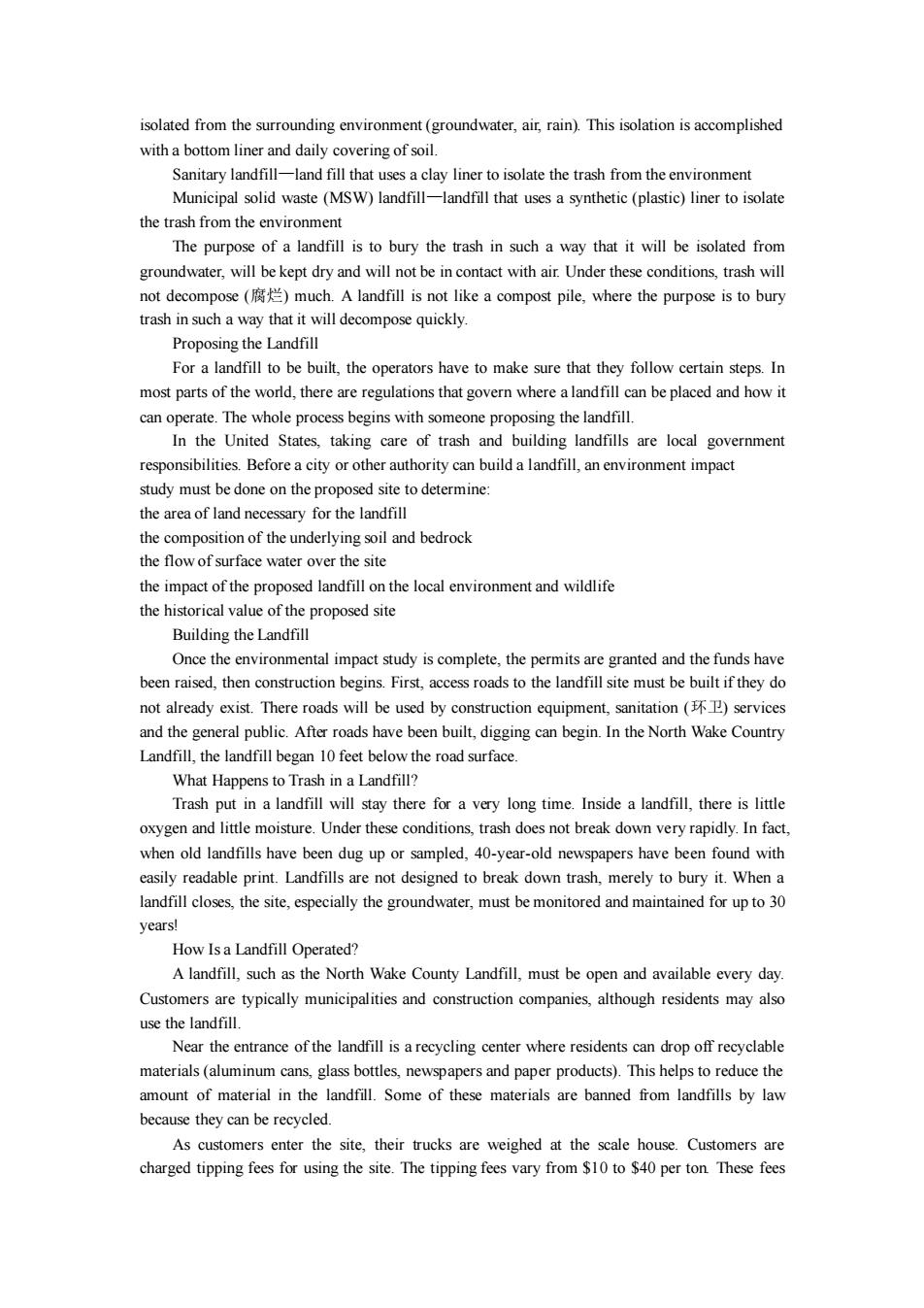
isolated from the surrounding environment (groundwater.air rain).This isolation is accomplished Sanitary landfil -land fill that uses a clay liner to isolate the trash from the environment Municipal solid waste (MSW)landfill-landfill that uses a synthetic (plastic)liner to isolate the trash from the environment The purpose of a landfill is to bury the trash in such a way that it will be isolated from not decompose(腐烂)muct A landfill is not like a compost pile,where the purpose is to bury trash in such a way that it will decompose quickly. Proposing the Landfill for a landfill to he built the onerators have to make sure that they follow certain stens in most parts of the world,there are regulations that govern where alandfll can be placed and how it can operate.The whole process begins with mn proposing the landfill In the United States,taking care of trash and building landfills are local government responsibilities.Before a city or other authority can build a landfill.an environment impact study must be done on the proposed site to determine: the area of land necessary for the landfill the impact of the proposed landfill on the local environment and wildlife the historical value of the proposed site Building the Landfill Once the environmental impact study is the perm nits ar egranted and the funds h een raised,the n beg not already exist.There roads will be used by construction equipment,sanitation (services and the general public.After roads have been built,digging can begin.In the North Wake Country Landfill.the landfill began 10 feet below the road surface. What Happens to Trash in a Landfill? Trash pu t in a landfill w ill sta ay there for a very long time.Inside a landfill,there is little oxygen and little moisture.Under these conditions,trash does not break down very rapidly.In fact when old landfills have been dug up or sampled,40-vear-old newspapers have been found with easily readable print.Landfills are not designed to break down trash,merely to bury it.When a landfill closes,the site,especially the groundwater,must be monitored and maintained for up to30 How Isa Landfill Operated A landfill,such as the North Wake County Landfill,must be open and available every day. Customers are typically municipalities and construction companies,although residents may also use the landfill Near of the landfill is center where residents can materials (aluminum epapers and paper products) This s helps to reduce the amount of material in the landfil Some of these materials are banned from landfills by law because they can be recycled. As customers enter the site.their trucks are weighed at the scale house.Customers are charged tipping fees for using the site.The tipping fees vary from$per ton These fees
isolated from the surrounding environment (groundwater, air, rain). This isolation is accomplished with a bottom liner and daily covering of soil. Sanitary landfill—land fill that uses a clay liner to isolate the trash from the environment Municipal solid waste (MSW) landfill—landfill that uses a synthetic (plastic) liner to isolate the trash from the environment The purpose of a landfill is to bury the trash in such a way that it will be isolated from groundwater, will be kept dry and will not be in contact with air. Under these conditions, trash will not decompose (腐烂) much. A landfill is not like a compost pile, where the purpose is to bury trash in such a way that it will decompose quickly. Proposing the Landfill For a landfill to be built, the operators have to make sure that they follow certain steps. In most parts of the world, there are regulations that govern where a landfill can be placed and how it can operate. The whole process begins with someone proposing the landfill. In the United States, taking care of trash and building landfills are local government responsibilities. Before a city or other authority can build a landfill, an environment impact study must be done on the proposed site to determine: the area of land necessary for the landfill the composition of the underlying soil and bedrock the flow of surface water over the site the impact of the proposed landfill on the local environment and wildlife the historical value of the proposed site Building the Landfill Once the environmental impact study is complete, the permits are granted and the funds have been raised, then construction begins. First, access roads to the landfill site must be built if they do not already exist. There roads will be used by construction equipment, sanitation (环卫) services and the general public. After roads have been built, digging can begin. In the North Wake Country Landfill, the landfill began 10 feet below the road surface. What Happens to Trash in a Landfill? Trash put in a landfill will stay there for a very long time. Inside a landfill, there is little oxygen and little moisture. Under these conditions, trash does not break down very rapidly. In fact, when old landfills have been dug up or sampled, 40-year-old newspapers have been found with easily readable print. Landfills are not designed to break down trash, merely to bury it. When a landfill closes, the site, especially the groundwater, must be monitored and maintained for up to 30 years! How Is a Landfill Operated? A landfill, such as the North Wake County Landfill, must be open and available every day. Customers are typically municipalities and construction companies, although residents may also use the landfill. Near the entrance of the landfill is a recycling center where residents can drop off recyclable materials (aluminum cans, glass bottles, newspapers and paper products). This helps to reduce the amount of material in the landfill. Some of these materials are banned from landfills by law because they can be recycled. As customers enter the site, their trucks are weighed at the scale house. Customers are charged tipping fees for using the site. The tipping fees vary from $10 to $40 per ton. These fees
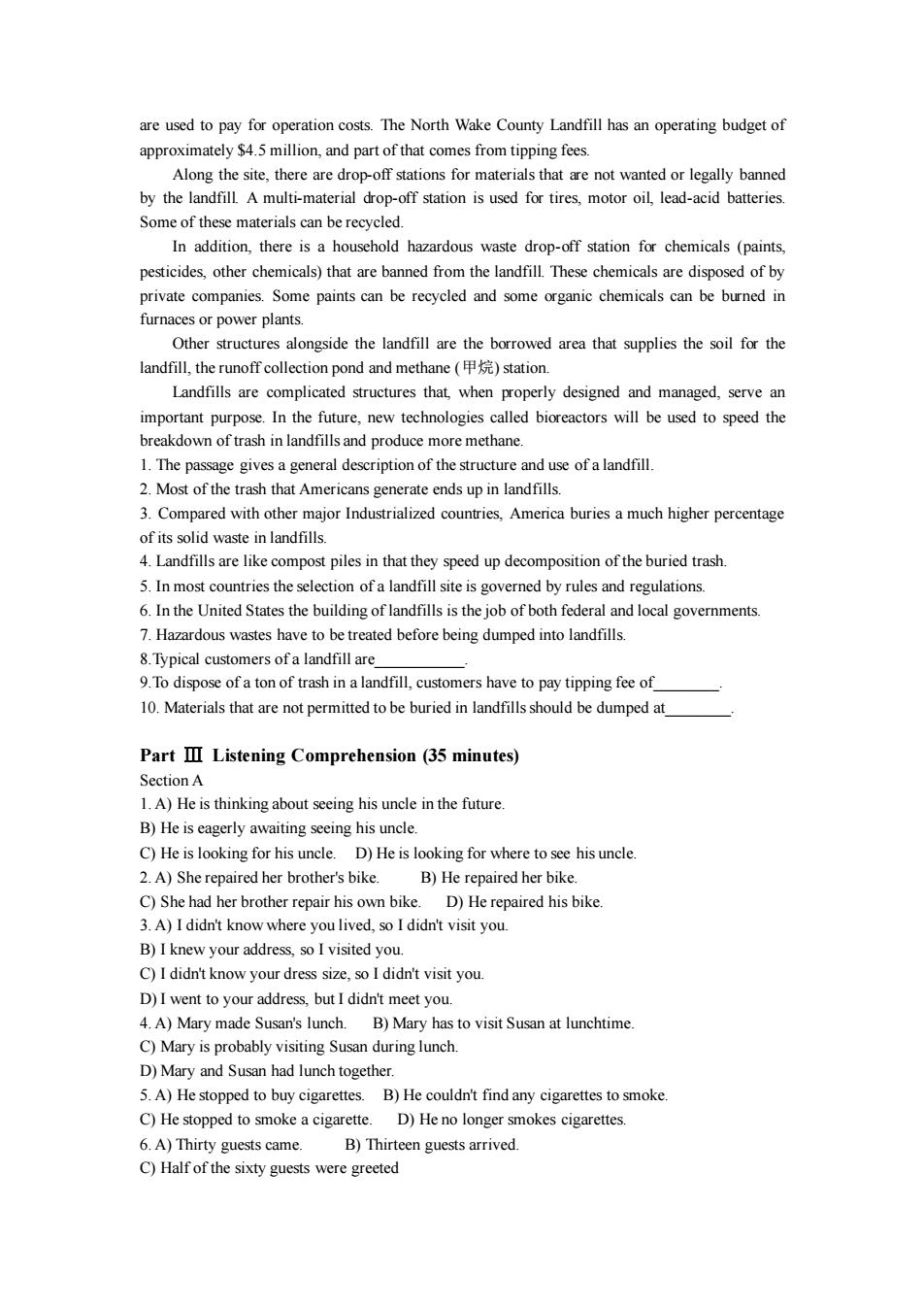
are used to pay for operation costs.The North Wake County Landfill has an operating budget of tely $4.5 million,and partmaterials that are not wanted Along he site,there are dropo st by the landfill A multi-material drop-off station is used for tires,motor oil,lead-acid batteries. Some of these materials can be recvcled. In addition.there is a household hazardous waste drop-off station for chemicals(paints, pesticides,other chemicals)that are banned from the landfill These chemicals are disposed of by private companie e paints can be recycled and some organic chemicals s can be bu urned in Turnaces or power plant Other structures alongside the landfill are the borrowed area that supplies the soil for the landfill,the runoff collection pond and methane (station. Landfills are complicated structures that,when properly designed and managed,serve an In the future.new called bioreactors will be used to speed the own of trash in landfills and produce more methane 1.The passage gives a general description of the structure and use of a landfill 2.Most of the trash that Americans generate ends up in landfills. 3.Compared with other major Industrialized countries.America buries a much higher percentage of its solid waste in landfills 4.Landfills are like ompost piles in that they speed up decomposition of the buried trash 5.Inmost countries the selection of a landfill site is governed by rule and regulations. 6.In the United States the building of landfills is the job of both federal and local governments. 7.Hazardous wastes have to be treated before being dumped into landfills. 8 Typical customers of a landfill are of a ton of trash inal ha e to pay tipping fee of Part III Listening Comprehension (35 minutes) Section A 1.A)He is thinking about seeing hisunce in the future B)He is eagerly awaiting seing hisunc C)He is looking for his uncle.D)He is looking for where to see his uncle 2.A)She repaired her brother's bike. B)He repaired her bike. C)She had her brother repair his own bike. D)He repaired his bike 3.A)Ididn't know where you lived,soIdidn't visit you. B)Ikew your you C)I didn't know your dress size.soI didn't visit you D)I went to your address.but I didn't meet you 4.A)Mary made Susan's lunch.B)Mary has to visit Susan at lunchtime. C)Mary is probably visiting Susan during lunch. D)man y and Susan had lunch togethe .A)He stopped to buy cigarettes B)He couldn't find any cigarettes to smoke C)He stopped to smoke a cigarette. D)He no longer smokes cigarettes. 6.A)Thirty guests came. B)Thirteen guests arrived. C)Half of the sixty guests were greeted
are used to pay for operation costs. The North Wake County Landfill has an operating budget of approximately $4.5 million, and part of that comes from tipping fees. Along the site, there are drop-off stations for materials that are not wanted or legally banned by the landfill. A multi-material drop-off station is used for tires, motor oil, lead-acid batteries. Some of these materials can be recycled. In addition, there is a household hazardous waste drop-off station for chemicals (paints, pesticides, other chemicals) that are banned from the landfill. These chemicals are disposed of by private companies. Some paints can be recycled and some organic chemicals can be burned in furnaces or power plants. Other structures alongside the landfill are the borrowed area that supplies the soil for the landfill, the runoff collection pond and methane (甲烷) station. Landfills are complicated structures that, when properly designed and managed, serve an important purpose. In the future, new technologies called bioreactors will be used to speed the breakdown of trash in landfills and produce more methane. 1. The passage gives a general description of the structure and use of a landfill. 2. Most of the trash that Americans generate ends up in landfills. 3. Compared with other major Industrialized countries, America buries a much higher percentage of its solid waste in landfills. 4. Landfills are like compost piles in that they speed up decomposition of the buried trash. 5. In most countries the selection of a landfill site is governed by rules and regulations. 6. In the United States the building of landfills is the job of both federal and local governments. 7. Hazardous wastes have to be treated before being dumped into landfills. 8.Typical customers of a landfill are___________. 9.To dispose of a ton of trash in a landfill, customers have to pay tipping fee of________. 10. Materials that are not permitted to be buried in landfills should be dumped at________. Part Ⅲ Listening Comprehension (35 minutes) Section A 1. A) He is thinking about seeing his uncle in the future. B) He is eagerly awaiting seeing his uncle. C) He is looking for his uncle. D) He is looking for where to see his uncle. 2. A) She repaired her brother's bike. B) He repaired her bike. C) She had her brother repair his own bike. D) He repaired his bike. 3. A) I didn't know where you lived, so I didn't visit you. B) I knew your address, so I visited you. C) I didn't know your dress size, so I didn't visit you. D) I went to your address, but I didn't meet you. 4. A) Mary made Susan's lunch. B) Mary has to visit Susan at lunchtime. C) Mary is probably visiting Susan during lunch. D) Mary and Susan had lunch together. 5. A) He stopped to buy cigarettes. B) He couldn't find any cigarettes to smoke. C) He stopped to smoke a cigarette. D) He no longer smokes cigarettes. 6. A) Thirty guests came. B) Thirteen guests arrived. C) Half of the sixty guests were greeted
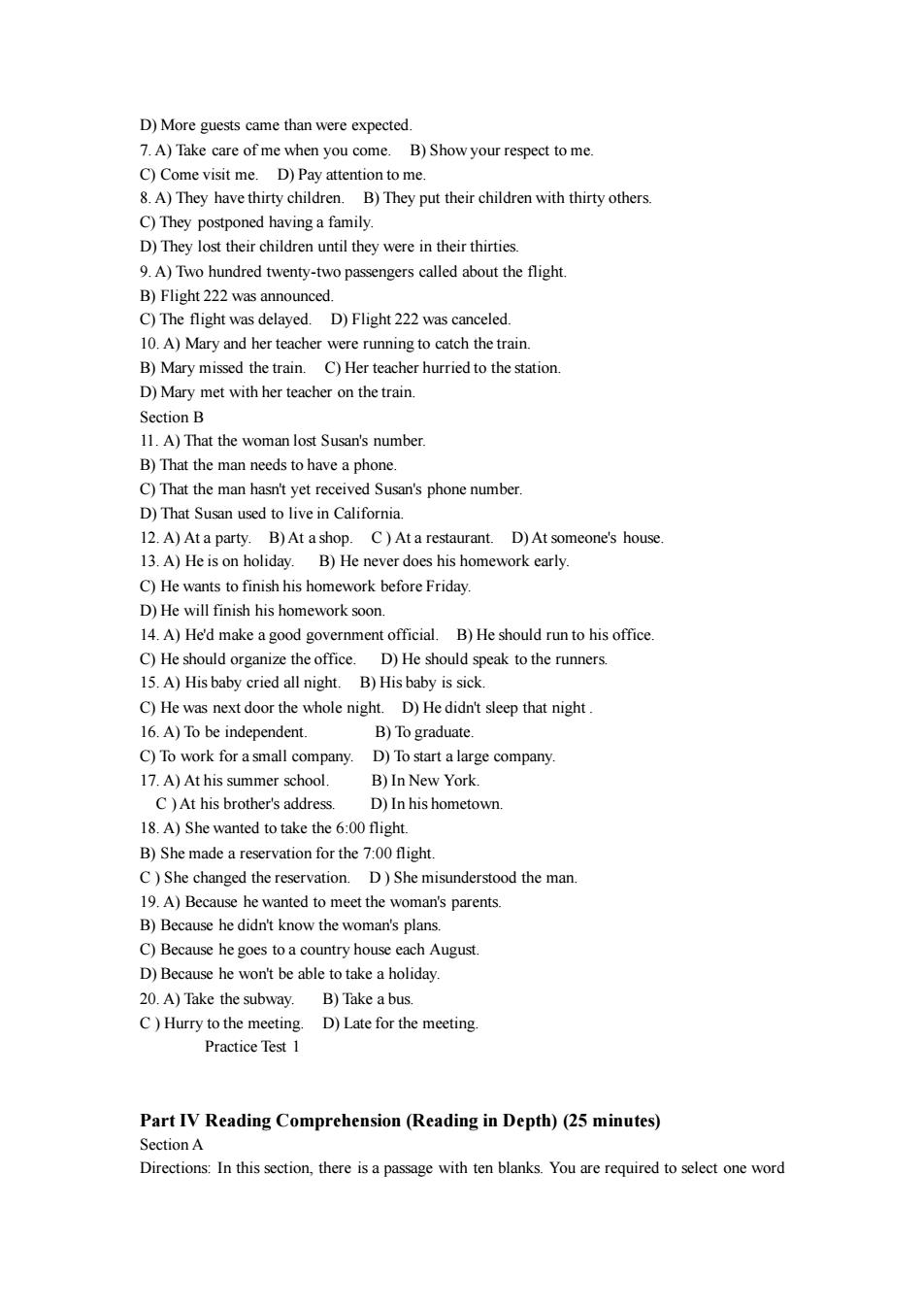
D)More guests came than were expected. 7.A)Take care of me when you come B)Show your respect to me C)Come visit me D)Pay attention to me 8.A)They have thirty children.B)They put their children with thirty others C)They postponed having a family. D)They lost their children until they were in their thirties 9.A)Two hundred twenty-two passengers called about the fligh B)Flight 222 was announce C)The flight was delayed.D)Flight 222 was canceled. 10.A)Mary and her teacher were running to catch the train. B)Mary missed the train.C)Her teacher hurried to the station. D)Mary met with her teacher on the train. Section B 11.A)That the woman lost Susan's number B)That the man needs to have a phone. C)That the man hasn't yet received Susan's phone number. D)That Susan used to live in California 12.A)Ata part C)Ata rant.D)At omeone's house 13.A)He ison holiday. B)He never does his homework early C)He wants to finish his homework before Friday. D)He will finish his homework soon. 14.A)He'd make a good government official.B)He should run to his office ze the office D)He should speak to the runners 15.A)His baby cried all night. B)His baby is sick C)He was next door the whole night. D)He didn't sleep that night 16.A)To be independent B)To graduate. C)To work for a small company.D)To start a large company r school B)In New York D)Inhis hometown 8.A)She wanted to take the 6:00fligh B)She made a reservation for the 7:00 flight. C)She changed the reservation.D)She misunderstood the man 19.A)Because he wanted to meet the woman's parents. B)Be cause he didn't know the oman's pl C)Because he goes toa country house each August D)Because he won't be able to take a holiday. 20.A)Take the subway B)Take a bus. C)Hurry to the meeting. D)Late for the meeting. Practice Test Part IV Reading Comprehension(Reading in Depth)(25 minutes) Section A Directions:In this section,there isa passage with ten blanks.You are required to select one word
D) More guests came than were expected. 7. A) Take care of me when you come. B) Show your respect to me. C) Come visit me. D) Pay attention to me. 8. A) They have thirty children. B) They put their children with thirty others. C) They postponed having a family. D) They lost their children until they were in their thirties. 9. A) Two hundred twenty-two passengers called about the flight. B) Flight 222 was announced. C) The flight was delayed. D) Flight 222 was canceled. 10. A) Mary and her teacher were running to catch the train. B) Mary missed the train. C) Her teacher hurried to the station. D) Mary met with her teacher on the train. Section B 11. A) That the woman lost Susan's number. B) That the man needs to have a phone. C) That the man hasn't yet received Susan's phone number. D) That Susan used to live in California. 12. A) At a party. B) At a shop. C ) At a restaurant. D) At someone's house. 13. A) He is on holiday. B) He never does his homework early. C) He wants to finish his homework before Friday. D) He will finish his homework soon. 14. A) He'd make a good government official. B) He should run to his office. C) He should organize the office. D) He should speak to the runners. 15. A) His baby cried all night. B) His baby is sick. C) He was next door the whole night. D) He didn't sleep that night . 16. A) To be independent. B) To graduate. C) To work for a small company. D) To start a large company. 17. A) At his summer school. B) In New York. C ) At his brother's address. D) In his hometown. 18. A) She wanted to take the 6:00 flight. B) She made a reservation for the 7:00 flight. C ) She changed the reservation. D ) She misunderstood the man. 19. A) Because he wanted to meet the woman's parents. B) Because he didn't know the woman's plans. C) Because he goes to a country house each August. D) Because he won't be able to take a holiday. 20. A) Take the subway. B) Take a bus. C ) Hurry to the meeting. D) Late for the meeting. Practice Test 1 Part IV Reading Comprehension (Reading in Depth) (25 minutes) Section A Directions: In this section, there is a passage with ten blanks. You are required to select one word
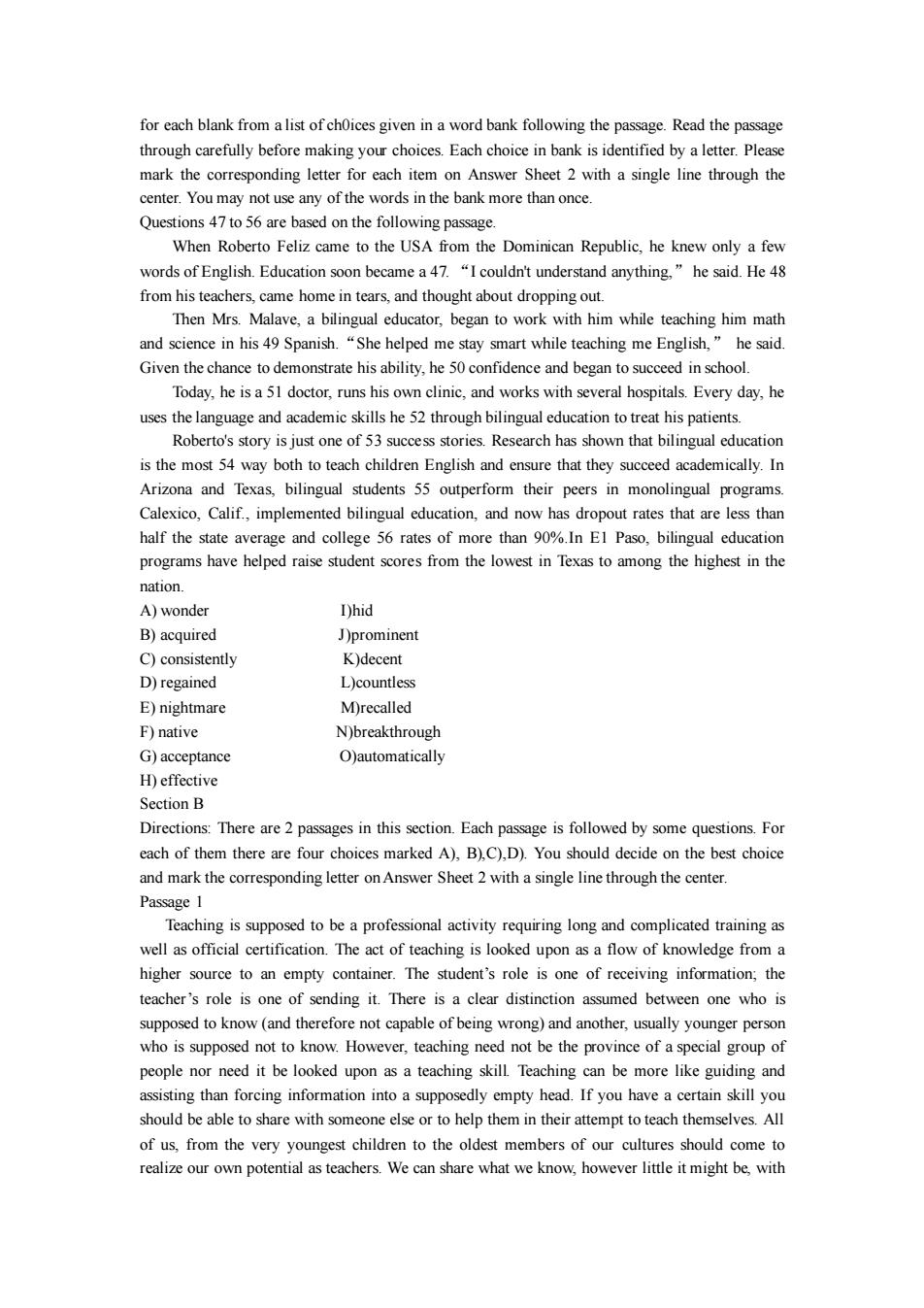
for each blank from alist of choices given in a word bank following the passage.Read the passage mark the corresponding letter for each center.You may not use any of the words in the bank more than once Questions 47to 56 are based on the following passage. When Roberto Feliz came to the USA from the Dominican Republic,he knew only a few words of English.Education soon became a47."Icouldn't understand anything."he said.He 48 from his te and science in his 49 Spanish."She helped me stay smart while teaching me English, he said. Given the chance to demonstrate his ability,he 50confidence and began to succeed in school. Today.he is a 51 doctor.runs his own clinic.and works with several hospitals Every dav.he uses Robertos story is just on Research has shown that bilingual education is the most 54 way both to teach children English and ensure that they succeed academically.In Arizona and Texas.bilingual students 55 outperform their peers in monolingual programs Calexico,Calif,implemented bilingual education,and now has dropout rates that are less than half the state ave 56 rates of more than 90%In El Paso bilingual education pro cores from the low est in Te、 as to among the highest in the nation. A)wonder Dhid B)acquired Oprominent C)consistently K)decent D)re ained E)nightmare M)recalled F)native N)breakthrough G)acceptance O)automatically H)effective Section B Directions There in this sction Each passae is followed by some questions.For each of them there are four choices marked A),B)C),D).You should decide on the best choice and mark the corresponding letter on Answer Sheet 2 with a single line through the center. Passage I Teaching is supposed to be a professional activity requiring long and complicated training as well as official ation.The act of teaching is looked upon asa flow of knov Medge from higher source to an empty container.The student's role is one of receiving information,the teacher's role is one of sending it.There is a clear distinction assumed between one who is supposed to know (and therefore not capable of being wrong)and another,usually younger person who is supposed not to know.However.teaching need not be the province of aspecial group of people no eed it be looked upon as a teaching skill Teaching n be more like gui and ing than forcing supposedy empty head.If you have a n yo should be able to share with someone else or to help them in their attempt to teach themselves.All of us,from the very youngest children to the oldest members of our cultures should come to realize our own potential as teachers.We can share what we know,however little it might be with
for each blank from a list of ch0ices given in a word bank following the passage. Read the passage through carefully before making your choices. Each choice in bank is identified by a letter. Please mark the corresponding letter for each item on Answer Sheet 2 with a single line through the center. You may not use any of the words in the bank more than once. Questions 47 to 56 are based on the following passage. When Roberto Feliz came to the USA from the Dominican Republic, he knew only a few words of English. Education soon became a 47. “I couldn't understand anything,” he said. He 48 from his teachers, came home in tears, and thought about dropping out. Then Mrs. Malave, a bilingual educator, began to work with him while teaching him math and science in his 49 Spanish.“She helped me stay smart while teaching me English,” he said. Given the chance to demonstrate his ability, he 50 confidence and began to succeed in school. Today, he is a 51 doctor, runs his own clinic, and works with several hospitals. Every day, he uses the language and academic skills he 52 through bilingual education to treat his patients. Roberto's story is just one of 53 success stories. Research has shown that bilingual education is the most 54 way both to teach children English and ensure that they succeed academically. In Arizona and Texas, bilingual students 55 outperform their peers in monolingual programs. Calexico, Calif., implemented bilingual education, and now has dropout rates that are less than half the state average and college 56 rates of more than 90%.In E1 Paso, bilingual education programs have helped raise student scores from the lowest in Texas to among the highest in the nation. A) wonder I)hid B) acquired J)prominent C) consistently K)decent D) regained L)countless E) nightmare M)recalled F) native N)breakthrough G) acceptance O)automatically H) effective Section B Directions: There are 2 passages in this section. Each passage is followed by some questions. For each of them there are four choices marked A), B),C),D). You should decide on the best choice and mark the corresponding letter on Answer Sheet 2 with a single line through the center. Passage 1 Teaching is supposed to be a professional activity requiring long and complicated training as well as official certification. The act of teaching is looked upon as a flow of knowledge from a higher source to an empty container. The student’s role is one of receiving information; the teacher’s role is one of sending it. There is a clear distinction assumed between one who is supposed to know (and therefore not capable of being wrong) and another, usually younger person who is supposed not to know. However, teaching need not be the province of a special group of people nor need it be looked upon as a teaching skill. Teaching can be more like guiding and assisting than forcing information into a supposedly empty head. If you have a certain skill you should be able to share with someone else or to help them in their attempt to teach themselves. All of us, from the very youngest children to the oldest members of our cultures should come to realize our own potential as teachers. We can share what we know, however little it might be, with
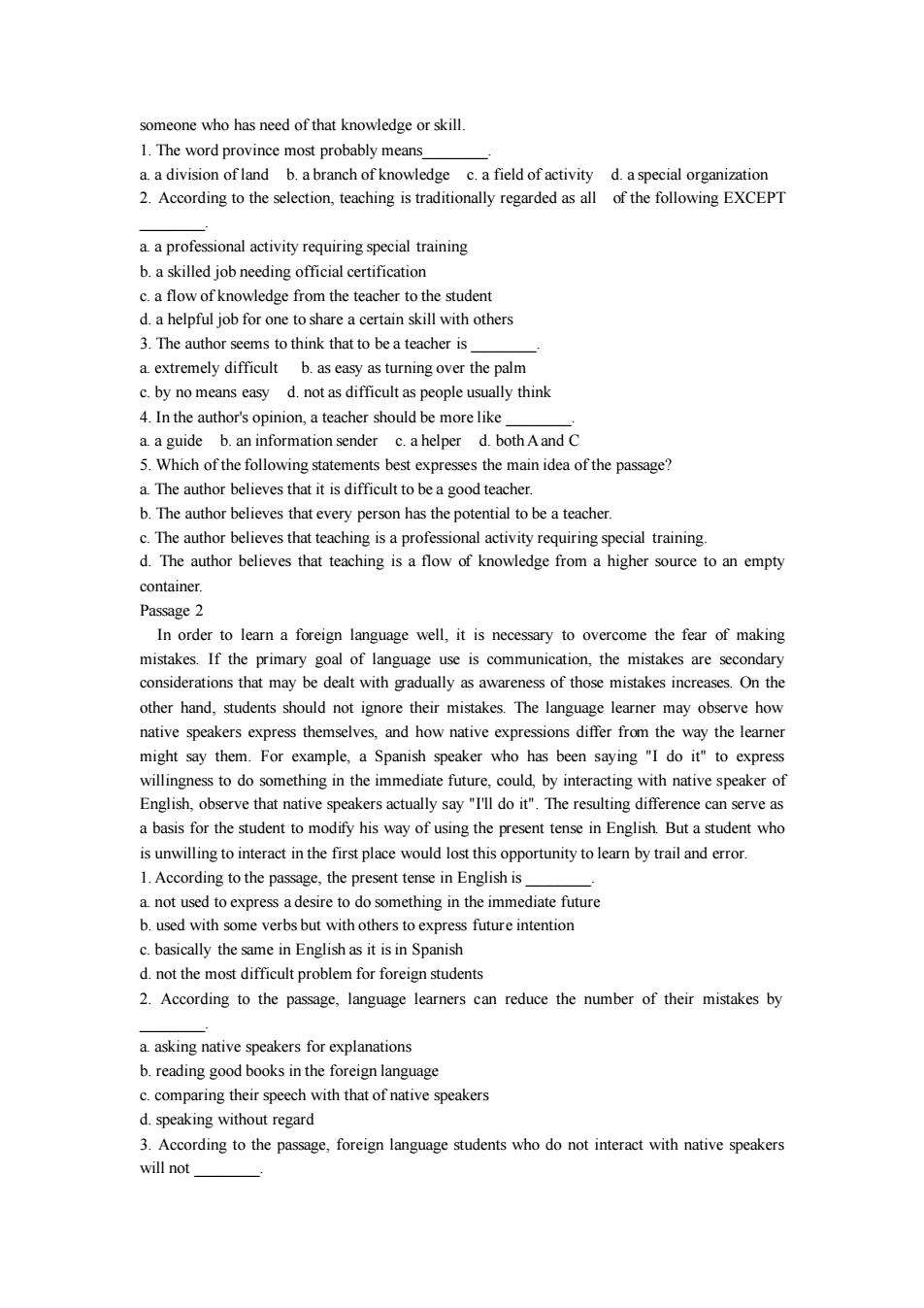
someone who has need of that knowledge or skill a.a division of land b.a branch of knowledge c.a field of activity d.a special organization 2.According to the selection,teaching is traditionally regarded as all of the following EXCEPT aa professional activity requiring special training .a flow ofknowledge from the teacher to the studen d.a helpful job for one to share a certain skill with others 3.The author seems to think that to be a teacher is a extremely difficult b.as easy as turning over the palm c.by no means easy d.not as difficult as people usually think aa guide b.an information sender c.ahelper d.bothAand 5.Which of the following statements best expresses the main idea of the passage? a.The author believes that it is difficult to be a good teacher. b.The author believes that every person has the potential to be a teacher Thnow kowoi r ihr ur mp container Passage 2 In order to learn a foreign language well.it is necessary to overcome the fear of making mistakes.If the primar oal of la on,the mistakes are seco mis akes ses.On other hand,students should not ignore their mistakes.The language learner may observe how native speakers express themselves.and how native expressions differ from the way the learner might say them.For example,a Spanish speaker who has been saying "I do it"to express willingness to do something in the in mediate future,could by inter with native speaker of ative sp ctually say "ldo it".The a basis for the student to modify his way of using the present tense in English.But a student who is unwilling to interact in the first place would lost this opportunity to learn by trail and error. 1.According to the passage,the present tense in English is a not used to express a desire to do something in the immediate future h used with rhs but with oth future intention c.basically the en English as it isin Spanish d.not the most difficult problem for foreign students 2.According to the passage,language learners can reduce the number of their mistakes by a asking native speakers for explanations b.reading good books in the foreign language c.comparing their speech with that of native speakers d.speaking without regard 3.According to the passage,foreign language students who do not interact with native speakers will not
someone who has need of that knowledge or skill. 1. The word province most probably means________. a. a division of land b. a branch of knowledge c. a field of activity d. a special organization 2. According to the selection, teaching is traditionally regarded as all of the following EXCEPT ________. a. a professional activity requiring special training b. a skilled job needing official certification c. a flow of knowledge from the teacher to the student d. a helpful job for one to share a certain skill with others 3. The author seems to think that to be a teacher is ________. a. extremely difficult b. as easy as turning over the palm c. by no means easy d. not as difficult as people usually think 4. In the author's opinion, a teacher should be more like ________. a. a guide b. an information sender c. a helper d. both A and C 5. Which of the following statements best expresses the main idea of the passage? a. The author believes that it is difficult to be a good teacher. b. The author believes that every person has the potential to be a teacher. c. The author believes that teaching is a professional activity requiring special training. d. The author believes that teaching is a flow of knowledge from a higher source to an empty container. Passage 2 In order to learn a foreign language well, it is necessary to overcome the fear of making mistakes. If the primary goal of language use is communication, the mistakes are secondary considerations that may be dealt with gradually as awareness of those mistakes increases. On the other hand, students should not ignore their mistakes. The language learner may observe how native speakers express themselves, and how native expressions differ from the way the learner might say them. For example, a Spanish speaker who has been saying "I do it" to express willingness to do something in the immediate future, could, by interacting with native speaker of English, observe that native speakers actually say "I'll do it". The resulting difference can serve as a basis for the student to modify his way of using the present tense in English. But a student who is unwilling to interact in the first place would lost this opportunity to learn by trail and error. 1. According to the passage, the present tense in English is ________. a. not used to express a desire to do something in the immediate future b. used with some verbs but with others to express future intention c. basically the same in English as it is in Spanish d. not the most difficult problem for foreign students 2. According to the passage, language learners can reduce the number of their mistakes by ________. a. asking native speakers for explanations b. reading good books in the foreign language c. comparing their speech with that of native speakers d. speaking without regard 3. According to the passage, foreign language students who do not interact with native speakers will not ________
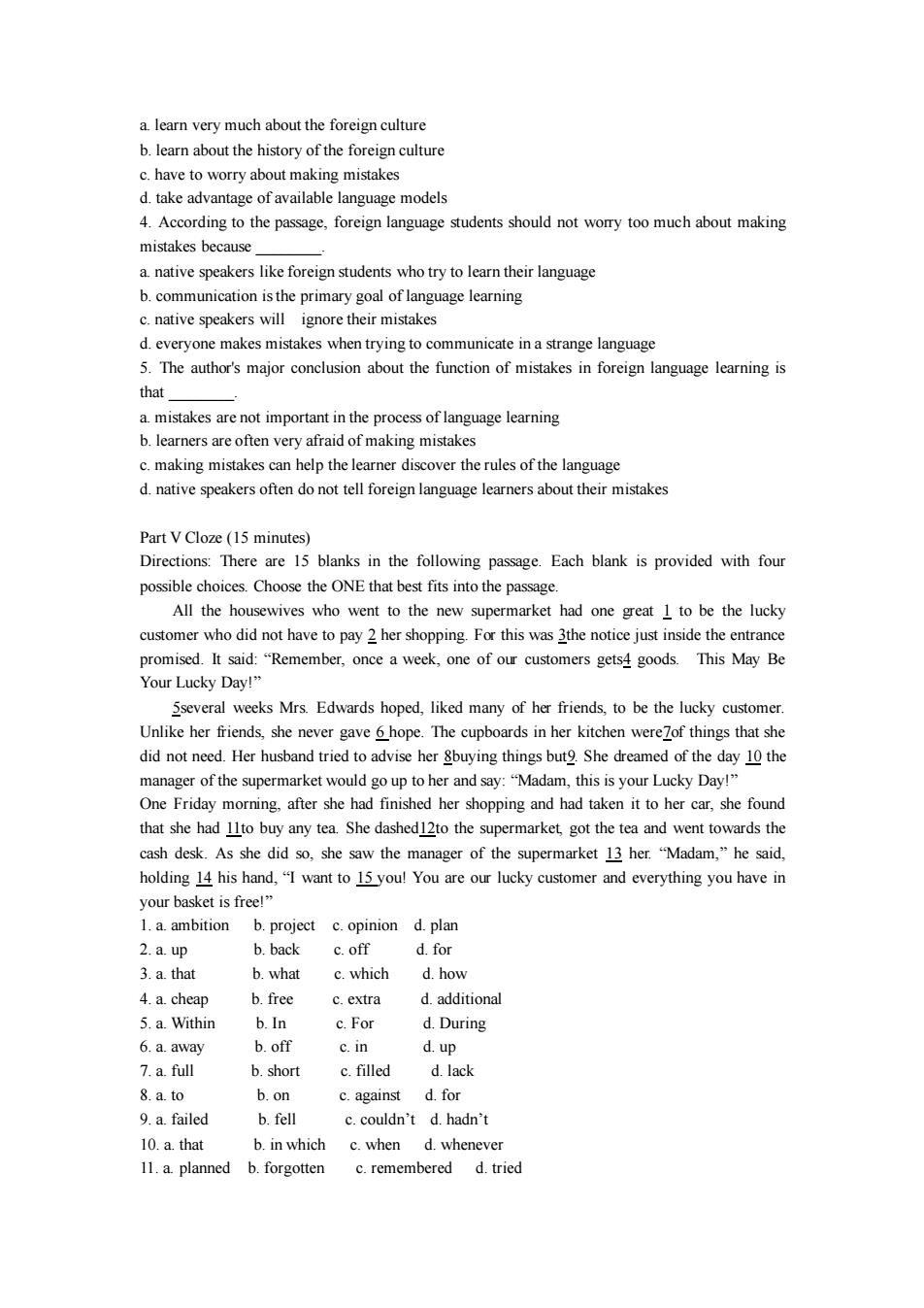
a.learn very much about the foreign culture b.learn about the history of the c.have to worry about making mistakes d.take advantage of available language models 4.According to the passage,foreign language students should not worry too much about making mistakes because c.native speakers will ignore their mistakes d.everyone makes mistakes when trying to communicate in a strange language 5.The author's major conclusion about the function of mistakes in foreign language learning is that a mistakes are not important in the ocess of la nguage learning b.learners are often very afraid of making mistakes c.making mistakes can help the learner discover the rules of the language d.native speakers often do not tell foreign language learners about their mistakes Part V Cloze (15 minutes) Directions:There are 15 blanks in the following passage.Each blank is provided with four possible choices.Choose the ONE that best fits into the passage. All the housewives who went to the new supermarket had one great 1 to be the lucky customer who did not have to pay 2 her shopping For this was 3the notice just inside the entrance promised.It said:"Remember,once a week.one of our customers gets4 goods.This May Be Your Lucky Day!" Sseveral weeks Mrs Edwards hoped,liked many of her friends,to be the lucky customer Unlike her friends,she never gave 6hope.The cupboards in her kitchen wereZof things that she did not need.Her husband tried to advise her 8buying things but9.She dreamed of the day 10 the manager of the supermarket would go up to her and say:"Madam,this is your Lucky Day!" her shopping and had taken it toher rcar,she found that she had to buy any tea.She the supermarket got the tea and went towards th cash desk.As she did so,she saw the manager of the supermarket 13 her."Madam,"he said, holding 14 his hand,"I want to 15 you!You are our lucky customer and everything you have in vour basket is free!” 1.a.ambition b.project c.opinion d.plan 2.a.up b.back c.ofe d for 3.a.that b.what c.which d.how 4.a.cheap b.free c.extra d.additional 5.a.Within b In c For d.During 6.a away b off c.in d.up 7.a.full b.short c.filled d.lack 8.a.to b.on c.against d.for 9.a.failed b.fell c.couldn't d.hadn't 10.a.that b.in which c.when d.whenever 11.a planned b.forgotten c.remembered d.tried
a. learn very much about the foreign culture b. learn about the history of the foreign culture c. have to worry about making mistakes d. take advantage of available language models 4. According to the passage, foreign language students should not worry too much about making mistakes because ________. a. native speakers like foreign students who try to learn their language b. communication is the primary goal of language learning c. native speakers will ignore their mistakes d. everyone makes mistakes when trying to communicate in a strange language 5. The author's major conclusion about the function of mistakes in foreign language learning is that ________. a. mistakes are not important in the process of language learning b. learners are often very afraid of making mistakes c. making mistakes can help the learner discover the rules of the language d. native speakers often do not tell foreign language learners about their mistakes Part V Cloze (15 minutes) Directions: There are 15 blanks in the following passage. Each blank is provided with four possible choices. Choose the ONE that best fits into the passage. All the housewives who went to the new supermarket had one great 1 to be the lucky customer who did not have to pay 2 her shopping. For this was 3the notice just inside the entrance promised. It said: “Remember, once a week, one of our customers gets4 goods. This May Be Your Lucky Day!” 5several weeks Mrs. Edwards hoped, liked many of her friends, to be the lucky customer. Unlike her friends, she never gave 6 hope. The cupboards in her kitchen were7of things that she did not need. Her husband tried to advise her 8buying things but9. She dreamed of the day 10 the manager of the supermarket would go up to her and say: “Madam, this is your Lucky Day!” One Friday morning, after she had finished her shopping and had taken it to her car, she found that she had 11to buy any tea. She dashed12to the supermarket, got the tea and went towards the cash desk. As she did so, she saw the manager of the supermarket 13 her. “Madam,” he said, holding 14 his hand, “I want to 15 you! You are our lucky customer and everything you have in your basket is free!” 1. a. ambition b. project c. opinion d. plan 2. a. up b. back c. off d. for 3. a. that b. what c. which d. how 4. a. cheap b. free c. extra d. additional 5. a. Within b. In c. For d. During 6. a. away b. off c. in d. up 7. a. full b. short c. filled d. lack 8. a. to b. on c. against d. for 9. a. failed b. fell c. couldn’t d. hadn’t 10. a. that b. in which c. when d. whenever 11. a. planned b. forgotten c. remembered d. tried

12.a.back b.away c.out d in 13.a.approached b.approach c.advanced d.advance 14.a.up b.back c.out d.on 15.a.thank b.celebrate c.welcome d.congratulate Part VI Translation 除了干早(drought)时期,人们从不把水看成宝贵的自然资源。诚然,水不是世界上的稀有之 物。地球表面百分之七十被水覆盖。如果天不下雨,我们偶尔会听到农民抱怨,但在有可靠 供水系统的城 有人感到缺水。如果有 个水管爆裂 ,水流调 地,我们也很少有人 赶紧去将它堵上。因为我们想当然地以为水与空气一样不值钱,什么地方都有。然而部分因 为人口增加,部分因为可怕的浪费,在当今世界的许多地方,供水已成为一大挑战。它已经 是一个不可置之不理的严重问题。如果不降低需求,减少浪费,我们在不久的将来就会面临 灾难
12.a. back b. away c. out d. in 13.a. approached b. approach c. advanced d. advance 14. a. up b. back c. out d. on 15. a. thank b. celebrate c. welcome d. congratulate Part VI Translation 除了干旱(drought)时期,人们从不把水看成宝贵的自然资源。诚然,水不是世界上的稀有之 物。地球表面百分之七十被水覆盖。如果天不下雨,我们偶尔会听到农民抱怨,但在有可靠 供水系统的城区,很少有人感到缺水。如果有一个水管爆裂,水流满一地,我们也很少有人 赶紧去将它堵上。因为我们想当然地以为水与空气一样不值钱,什么地方都有。然而部分因 为人口增加,部分因为可怕的浪费,在当今世界的许多地方,供水已成为一大挑战。它已经 是一个不可置之不理的严重问题。如果不降低需求,减少浪费,我们在不久的将来就会面临 灾难